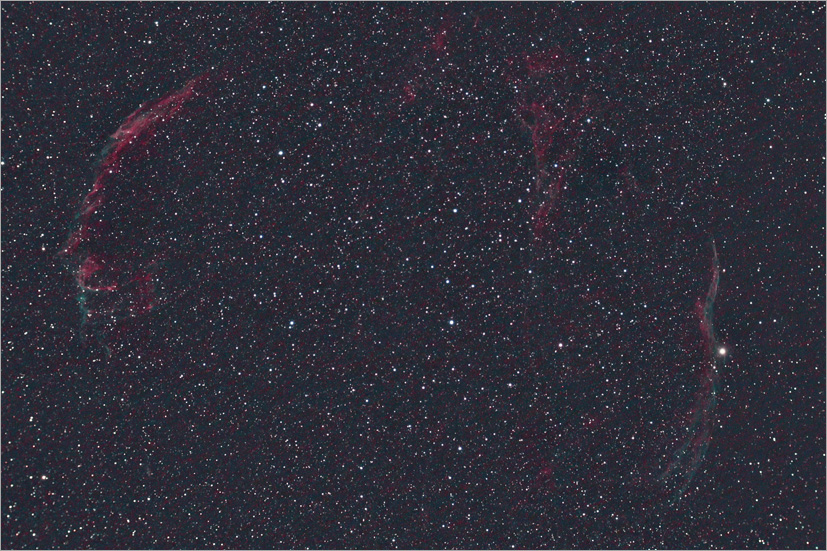
Dark Skies and Stacking
The Veil Nebula
Yes, you can shoot JPEG light frames and subtract JPEG dark frames.
In this example, 10 individual JPEG dark frames were averaged together to create a master dark frame. This master dark was then subtracted from each individual light frame. The light frames were then stacked and averaged together.
Since the Veil is faint, shooting multiple exposures from a dark-sky site with a deep-sky filter and stacking them really helped make this a better photo.
|
|
The Veil Nebula is also known as the Cygnus Loop or Cirrus Nebula. It is very large at about 3 degrees in diameter.
NGC 6992/95 is the brighter eastern half of the nebula at left. NGC 6960, The Witch's Broom, appears close to the bright star 52 Cygnii at lower right.
Pickering's Triangular Wisp, above and to the left of the NGC 6960, is designated as Simeis 3-188. At the top center of the photo is a small patch of the Veil designated as NGC 6974/79.
The Veil nebula complex is the remnants of a supernova which exploded about 5,000 to 10,000 years ago. Its distance is estimated to be about 1,400 light years from Earth. It was discovered by William Herschel in 1784.
The glowing nebula in the Veil is formed by the shock wave of material from the supernova heating and interacting with the interstellar medium.
In the old days, the Veil nebula was considered quite a challenge, even for visual observers in large telescopes. Parts of it are rather faint.
Today, it is much easier, both visually and photographically, because we can use filters. Visually, an Oxygen III or UHC (Ultra High Contrast) filter can really help the Veil to pop out. I have even observed it visually in binoculars equipped with UHC filters. Photographically, a deep-sky or LPS filter can also really help to record the red and green emission lines in the Veil, even with a stock, unmodified camera.
Image Data
- Lens / Scope: Stellarvue SV70ED ED doublet refractor
- Focal Length: 336mm
- F/stop: f/4.8 with William Optics 0.8x Telecompressor / Reducer
- Exposure: Stack of ten 4-minute exposures (40 minutes total exposure)
- Mount: Orion Sirius polar-aligned German-equatorial mount
- Guiding: None
- Camera: Unmodified Canon EOS 1000D (Digital Rebel XS)
- Mode: JPEG
- ISO: 1600
- White Balance: Custom, set on sky background
- In-Camera Noise Reduction: Off
- Filter: Lumicon Deep-Sky filter
- Temp: 65F
- Start Time: 12:56 a.m.
- Date: June 28, 2009
- Location: Batsto, NJ
- Calibration: Master Dark frame made from 10 individual JPEG darks
- Processing: JPEG lights calibrated and stacked. Stacked in Deepsky Stacker. Contrast, color adjustments in post processing.